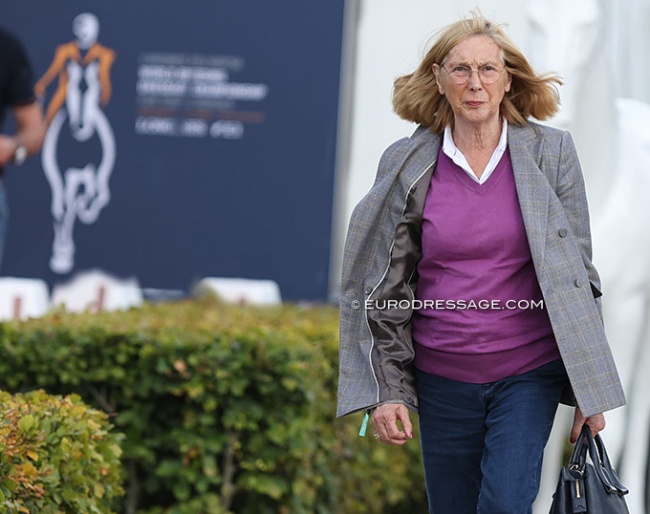
-- Text by Angelika Frömming for Eurodressage
Traditionally, the general principle applies that the horse's movements become more beautiful through proper and professional training. In order to be able to better implement this postulate, the young dressage horse test was introduced to gauge the quality of training, or as Johann Wolfgang von Goethe phrased it, “anyone who misses the first buttonhole cannot cope with buttoning up.”
After a first test attempt in Münster in 1982 it took until 1986 to establish a nationwide young horse judges’ training programme and the development of guidelines. The international pilot event of the World Championship for Young Dressage Horses was held in Verden only in 1997.
Young Dressage Horse Tests
It makes sense to remember the basic ideas of the initiators of the dressage horse tests. The key opinion leader in Germany at the time was Dr. Reiner Klimke. Internationally, this form of testing was supported by the World Breeding Federation for Sport Horses (WBFSH) and made known worldwide by the Fédération Equestre International (FEI), particularly through Mariette Whitages.
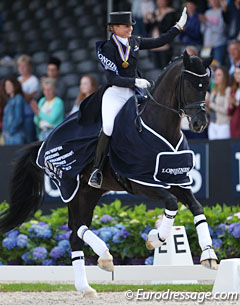
the inaugural edition of the 7-YO World Young
Horse Championships in 2016
Much more important, however, were the trends that were to be achieved with these dressage horse tests: Natural ability and natural movement quality over routined movements. This means the horse is relaxed, the back swings, and the movement are natural! The originators of this kind of test were concerned with the naturalness of the movements and not with artificially trained movement sequences. Anything artificial and tense should be marked negatively. The dressage horse test should develop into a showcase for breeding and the level of training in terms of natural movements and natural ability.
For an overall assessment, the judges were given terms such as, absence of force, naturalness, elasticity, suppleness, effortlessness, lightness, handiness, agility and harmony. The performance should always be unconstraint. At the same time, it was also pointed out nationally and internationally: “A crystal ball is needed to tell if the horse is going to make a Grand Prix horse.”
A Score Comparison between Bundeschampionate and World YH Championships
I am a declared supporter of young dressage horse tests and I am convinced that professional training benefits the horses' movements. With this attitude and the previously mentioned considerations in mind, I compared the marks for the basic gaits of the 5-, 6- and 7-year-old horses in the final tests at both the Bundeschampionate (German Championships for young horses) in Warendorf and at the World Championships for Young Horses in Ermelo 2023.
Only grades 8 and above, that means good and better, were counted. After all, both events were for the best of the best.
Bundeschampionat (2023 in Warendorf):
Marking of the basic gaits at the dressage horse classes of the 5-, 6- and 7-year-old horses with 8,0 and better.
| Percentage of horses with 8,0 and better |
Trot (in%) | Walk (in%) | Canter (in%) |
| 5-year-old (21 horses) | 100 | 52 | 90 |
| 6-year-olds (20 horses) | 90 | 90 | 90 |
| 7-year-olds (17 horses) | 82 | 53 | 71 |
World championships (2023 in Ermelo):
Marking of the basic gaits at the dressage horse classes of the 5-, 6- and 7-year-old horses with 8,0 and better.
| Percentage of horses with 8,0 and better |
Trot (in%) | Walk (in%) | Canter (in%) |
| 5-year-old (21 horses) | 87 | 87 | 87 |
| 6-year-olds (20 horses) | 87 | 60 | 93 |
| 7-year-olds (17 horses) | 80 | 67 | 67 |
To explain the table, it has to be mentioned that a different judging procedure is used for 7-year-old horses than for 5- and 6-year-olds. For the 5- and 6 year- old horses, only “quality judging” is used according to the guidelines provided. For the 7-year-olds, one group of judges follows “Quality Judging”, while another group of judges follows “Technical Judging”. This means that one group of judges judges the test like a normal dressage test (“technical judging”), while the other group of judges judges the quality of the movements and natural ability (“quality judging”).
In order to be able to compare the three age groups, I have only used the marks from “Quality judging” for the present table and the evaluation of the 7-year-old horses.
Why Do 7-YOs Score Less on Basic Gaits?!

at the WCYH in Ermelo
Is it possible that the required program of the final is still too difficult and too demanding for the 7-year-old horses? Does the complexity of it corresponds to the requirements for these comparatively young horses? Does the concept of the program correspond more to the possibilities of the “early developers” who are confident in the movements or does it also give horses with average talent “in terms of movements” a chance? As a reminder: During the young dressage horse test, the basic work in regards to the naturalness of the movement and the natural ability of the 7-year-olds should be checked and not the technical skills in first place.
Is the sequence of movements too fast? The time factor has been an argument for designing shorter tests for years! Do the comparatively young horses have enough time to catch their breath between movements? Is there enough time to show a “good” canter, especially during canter work? Or is it true: “The end of one movement is the beginning of the preparatory work for the next movement”? Is there a general agreement about the appearance of “good” collection in the three basic gaits at the 7-year-old horses?
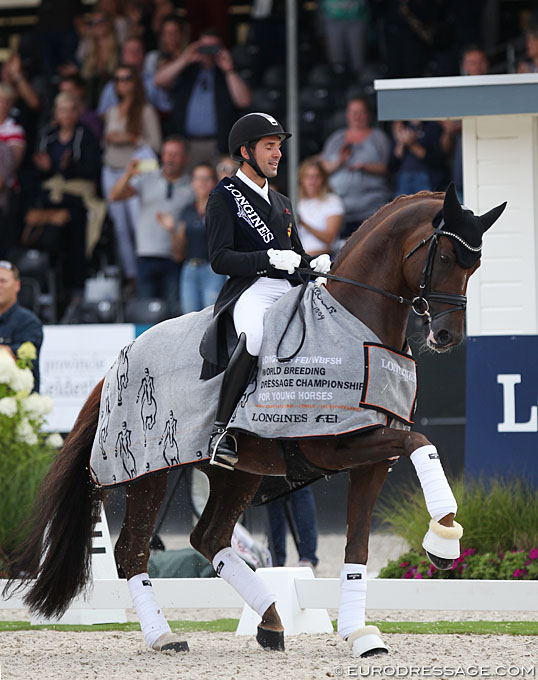
Championships in 2019
Another consideration at this age is that growth and development spurts are still occurring, which could continue to play a role and which must be taken into account when designing programs. The 7-year-old horses in particular have to cope with a lot, mentally and physically: new lessons, increased collection, and occasional introduction to “half steps” and passage attempts at home. At the same time, the thrusting power and space gain should not be neglected when it comes to extensions. Perhaps it is also possible that due to frequent “testing” during trot work, the 7-year-olds no longer differentiate accurately between a collected trot and a passage-like trot movement in which „expressive front-legs“ might dominate.
Isn't the 7-YO test Too Demanding?
The question has to be asked: Is the focus of the training of these 7-year-old horses at this point more on the technique of the movements than on the aspects of the training scale and therefore the continuation of good basic gaits?
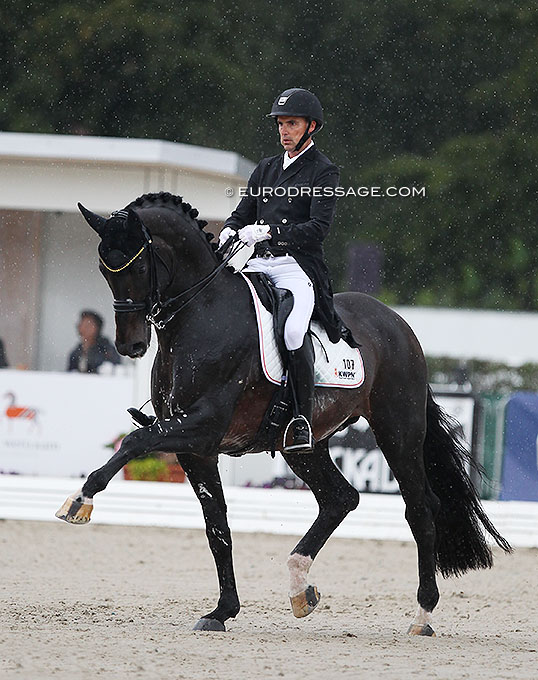
straight from this division into the Grand Prix
at age 8
If it is really the case that the 8-year-old horses only begin to improve their basic gaits once they have achieved a certain level of technical security in the movements, I would not see this development as reassuring, but rather as worrying. That would mean that our requirements profile for the 7-year-olds is too demanding and the basic work in favour of the movements is neglected for a certain time.
It always makes sense to give yourself enough time when training young horses, paying particular attention to the training scale, so that you can respond to the horses' individual possibilities without time pressure. In this context, the question of championships with high “market" value and the associated time pressure in the training and presentation of seven-year-old horses comes up, which means that technical training can temporarily dominate in this age group.
Finally, when preparing for a specific show, even 7-year-old horses can have problems with the training cycle. Wanting to improve every day can lead to a low point on the actual day of competition. In order to avoid such a low point, the horse's training management must be adjusted accordingly.
Conclusion:
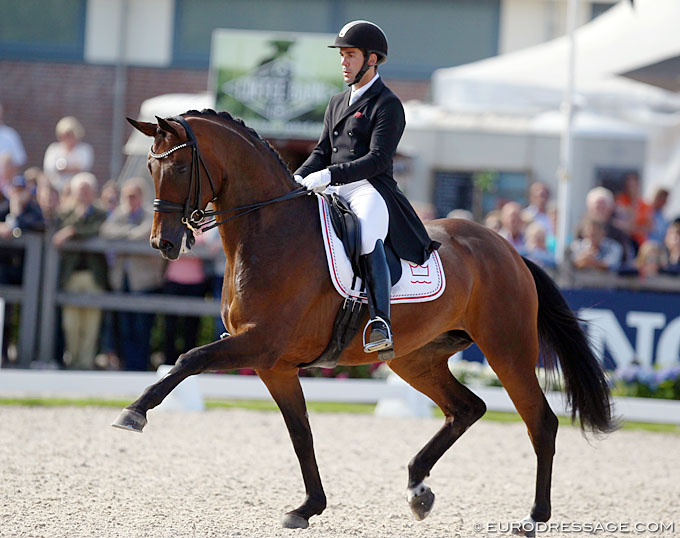
She moved from the 7-YO division straight into the
Grand Prix at age 8. She hasn't competed since
September 2021
If the present result was not a slip-up, you should think about introducing the judging method for 5- and 6-year-old horses (Quality Judging) also for 7-year-old horses. At the same time, one could consider offering 8-year-olds the same judging process (Quality and Technical Judging) that is already used for 7-year-olds. Consequently, this would mean that a Grand Prix would only be permitted for 9-year-olds and older horses. An almost bold idea, but one that is entirely in line with horse welfare.
It is our job as “stakeholders” to do everything we can to ensure that our 7-year-old horses also receive “good” marks for the quality of their basic gaits and, above all, maintain them. Here a quote from Antoine de la Baume Pluvinel (1555-1620) is appropriate: „But we should be careful not to rob horses of their natural charm, their grace, because this would be comparable to the delicate ripeness of the fruit, which once disappeared, never returns.“
By Angelika Frömming
Photos © Astrid Appels
Related Links
Angelika Frömming: "To Win or Not To Win, That is the Question"
Fromming & Stammer Seminar 2021: Nuggets of Wisdom from Angelika Fromming
Trainining with Frömming: "Getting a Classically Schooled, Yet Incorruptible Eagle Eye of a Judge"
Angelika Fromming: Open Scoring and Expert Commentary to Popularize Dressage
Fromming and Hinnemann: The Training Scale in Theory and Practise at Pineland Farms